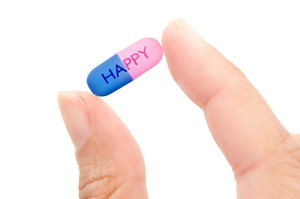
If you have been diagnosed with depression or a mood disorder, it is likely that you will be prescribed an antidepressant to help alleviate your symptoms. As a consumer, you have the right to know what these drugs are, how they work, and what they can and cannot do.
What are Antidepressants?
Antidepressants are prescribed psychiatric medications that are used to alleviate the symptoms of mood disorders, such as major depressive disorder (clinical depression) and anxiety disorders. They will not cure a disorder and they do not take effect instantly. Generally, you should wait at least six weeks before deciding that a certain medication is ineffective. Antidepressants alleviate symptoms by altering the levels of certain neurotransmitters in the brain.
Who Can Prescribe Antidepressants?
The only professionals who have the ability to prescribe medications are medical doctors and Nurse Practitioners. Medical doctors are those whose name is followed by MD or DO; Psychiatrists are medical doctors. A Nurse Practitioner is a registered nurse who has completed additional certification and who may have specialized in Psychiatry. Psychologists are not permitted to prescribe medications.
Is There More Than One Type of Antidepressant?
Yes. There are a few different kinds of antidepressants available to you today. Selective Serotonin Reuptake Inhibitors (SSRIs) are the most commonly prescribed antidepressants for those starting treatment for depression. As their name suggests, they work by specifically targeting the neurotransmitter called serotonin. SSRIs are safe and effective but may cause sexual side effects. Some of the most well-known antidepressants, such as Prozac, Zoloft, and Paxil, are found in this category. Tricyclic and tetracyclic antidepressants are older antidepressants. They work by boosting the levels of the neurotransmitters norepinephrine and serotonin. They are effective, however, doctors prefer to prescribe other antidepressants first because of the numerous side effects cyclics can cause. In some cases, low doses of cyclic antidepressants are prescribed in conjunction with another type of antidepressant to increase its effects on a patient’s mood. Older adults and those with low blood pressure or certain heart problems are typically not prescribed cyclics. Monoamine oxidase inhibitors (MAOIs) have numerous potentially serious side effects and are used as a last resort; however, these medications can be effective in cases where other antidepressants have failed to produce noticeable results. Dietary restrictions are necessary as certain foods and beverages consumed may cause fatally high blood pressure. These medications elevate your norepinephrine and serotonin levels by blocking an enzyme that deactivates them. Atypical antidepressants are referred to as “atypical” because they do not exactly fit into any of the other categories. These antidepressants appear to cause fewer sexual side effects than the other antidepressants. Wellbutrin is a well-known atypical antidepressant.
Is There a Risk of Suicide or an Increase in Suicidal Thoughts?
The FDA requires antidepressants to carry a black box warning. Children, teens and young adults between the ages of 18 and 24 may experience increased suicidal thoughts or behavior while taking an antidepressant, especially in the first few weeks. Family members, teachers, friends, and health providers such as their therapist or doctor should watch for any indicating signs that the patient is thinking of suicide. When placing one of these patients on an antidepressant, the doctor has decided that the benefits far outweigh the risks.
How Do I Know Which Antidepressant is Right for Me?
Your doctor will take quite a few factors into consideration when prescribing an antidepressant, including the possible side effects, its effectiveness on a close relative, such as a parent or sibling, its interaction with other medications you are currently taking, and any other health conditions you have.
Get professional, online help with information about antidepressants and its use at the Virtual Therapist Network
This article may be freely distributed in its entirety in any e-zine, newsletter, blog, or website as long as the website links remain intact, unchanged, and are included, in their entirety, with every reproduction.